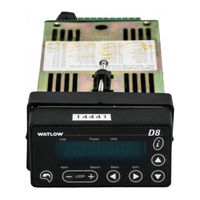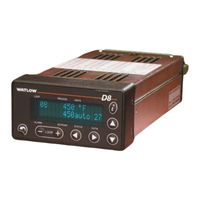User Manuals: Watlow Controller Series D8 Temperature
Manuals and User Guides for Watlow Controller Series D8 Temperature. We have 2 Watlow Controller Series D8 Temperature manuals available for free PDF download: User Manual, Specifications
Watlow Controller Series D8 User Manual (179 pages)
Brand: Watlow
|
Category: Controller
|
Size: 13 MB
Table of Contents
-
-
-
D8 Cabling18
-
Tb5018
-
Safety18
-
-
-
-
Input Object53
-
Alarm Object56
-
Ratio Object58
-
-
Keypad62
-
Displays62
-
Loop Display62
-
Job Display65
-
-
Autotuning72
-
-
-
-
-
-
-
BCD Job Load100
-
Mode Override102
-
Default: 0103
-
Default: off103
-
Keypad Lock104
-
Mac ID105
-
Baud Rate105
-
Off105
-
Module LED106
-
Network LED106
-
Bus off Count106
-
Input Menu107
-
01 Input Type107
-
Loop Name108
-
01 Input Units108
-
Display Format110
-
Input Range High110
-
Input Range Low111
-
Input Low Signal111
-
Input Filter112
-
-
Control Menu112
-
Output Menu116
-
Heat/Cool Action118
-
Alarms Menu121
-
Alarm Low Output125
-
Alarm Hysteresis125
-
01 Alarm Delay126
-
Cascade Menu128
-
Ratio Menu129
-
I/O Tests Menu131
-
Digital Inputs131
-
Keypad Test132
-
Display Test132
-
-
-
Alarm Enable133
-
Alarm Function134
-
Alarm Status134
-
-
-
Low Power140
-
Battery Dead140
-
Keys Do Not Work142
-
Earth Grounding143
-
-
Clearing the RAM145
-
-
Input Circuit148
-
Current Inputs149
-
Voltage Inputs149
-
RTD Inputs150
-
-
-
-
Glossary161
-
Index169
-
Menu Structure177
-
How to Reach Us179
-
Advertisement
Watlow Controller Series D8 Specifications (4 pages)
Full Featured Controller in a 1/8 DIN Package with DeviceNet
Brand: Watlow
|
Category: Controller
|
Size: 0 MB

